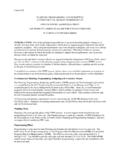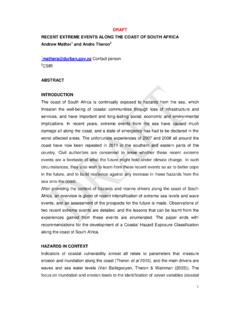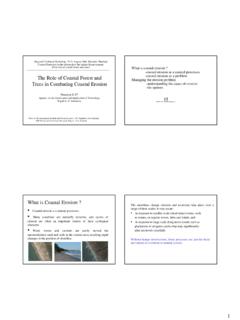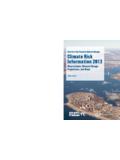Transcription of Fact Sheet Sea Level Rise Risk Assessment for DoD Coastal ...
1 REVISED 11/13/2009 Sea Level Rise Risk Assessment for DoD Coastal Installations Project # 08-410 Background: The consensus of the international scientific community is that future sea- Level rise based on climate model output will result in an increase in global eustatic sea- Level of between feet by 2100, with a "best estimate" of feet. This is more than double the rate of eustatic (global sea Level ) rise for the past century. These sea Level rise projections were recently updated in the 2007 Intergovernmental Panel on Climate Change (IPCC) which reported a to feet rise in sea Level by 2100.
2 Uncertainty in ice- Sheet decay models has some scientists calling the estimate conservative . A report in the January 2007 issue of Science calls for a to foot increase in sea Level rise by 2100. Coastal North Carolina has been identified as one of the United States most vulnerable regions to climate change. More than 2,000 square miles of North Carolina s Coastal ecosystems and urban areas are below one-meter elevation and within the range of projected sea Level rise from climate change for the year 2100.
3 Recent studies have demonstrated that, as climate change contributes to inundation, increased shoreline erosion and higher hurricane intensity, Coastal DoD installations may experience significant losses in the absence of mitigation and local adaptation. The shore line of Dare County, NC illustrates the conversion of Coastal forests to open water. As the sea Level rises forests are first replaced with shrub and marsh vegetation and then gradually transition to open water. Tree boles from what was formerly forestland can bee seen rising from the sound.
4 Objective: Given current controversy regarding observed sea Level rise in the 20th century, it is not surprising that there is a wide range of predictions of sea Level rise for the 21st century. Future sea Level rise consists of contributions from continued warming of the ocean as well as melting of glaciers, small ice sheets and Greenland. Installation natural and cultural resources and operations managers would like a particular value of sea Level rise to be associated with a specific Intergovernmental Panel on Climate Change sea Level rise scenarios illustrating the range and rate of sea Level rise projections.
5 Additional fixed rates of sea Level rise were added to SLAMM modeling for inclusion of additional glacial and polar ice cap melting projections. probability of occurrence. It is important to note that the main cause of uncertainty prior to about 2050 is caused by the lack of agreement on the processes that cause ice Sheet melt and associated dramatic increases in sea Level rise. Because of the thermal inertia of the oceans, there is little difference in the various sea Level rise projections before about 2050, after which different rates of warming due to different projections of future greenhouse concentrations result in large differences in sea Level rise.
6 We conducted risk assessments of natural, cultural, and operational resources at risk in five Coastal DoD installations in North Carolina (Air Force Dare County Bombing Range, Marine Corps Air Station and Naval Aviation Depot Cherry Point, Marine Corps Base Camp Lejeune, Military Ocean Terminal Sunny Point, and Navy Harvey Point). REVISED 11/13/2009 Summary of Approach: We used available LiDAR digital elevation data for installations and geospatially referenced inventories of natural, cultural, and operations resources.
7 Internationally recognized sea Level rise model scenarios from the most recent 2007 IPCC Assessment were used to project best and worse case sea- Level rise scenarios to 2100. Changes in vegetation land cover and open water in response to sea- Level rise were modeled using the SLAMM model that simulates the dominant processes involved in wetland conversions and shoreline modifications during long-term sea Level rise. Successive versions of the model have been successfully demonstrated to estimate impacts sea- Level rise on the coasts of the by the US EPA, US Fish and Wildlife Service, and the National Wildlife Federation.
8 Risk assessments of natural, cultural, and operations resources on installations were projected at ten year intervals to 2100. GIS map products and inventories of resources at risk were produced for each installation during the project. Potential mitigation strategies are discussed for each installation. Benefit: Climate change will stress the military by affecting weapons systems and platforms, bases, and military operations. The nature and rate of climate change being observed today and the future consequences being publicly debated by the international scientific community are grave and pose challenges to our national security and the natural and cultural resource of DoD installations.
9 The project s sea Level rise risk Assessment moves beyond the arguments of cause and effect and begin planning to address its potentially devastating effects. The consequences of climate change and sea Level rise are clear, the disruption of the organization, training, equipping, and planning of the military services. The goal of this project is to quantify the risk of sea Level rise on the ability of the services to execute its mission in support of national security and the stewardship of the nation's natural and cultural resources.
10 The project also contributes to state and regional climate change initiatives. Accomplishments: A summary of sea Level rise projections for North Carolina Coastal installations indicates that DoD installations will have varying degrees of risk based on actual sea Level rise from present to 2100. The two installations facing the greatest risks from sea Level rise are DCBR and Cherry Point Piney Island (BT11). SLAMM simulations indicate that a moderate sea Level rise of approximately m will flood large portions of these installations.










